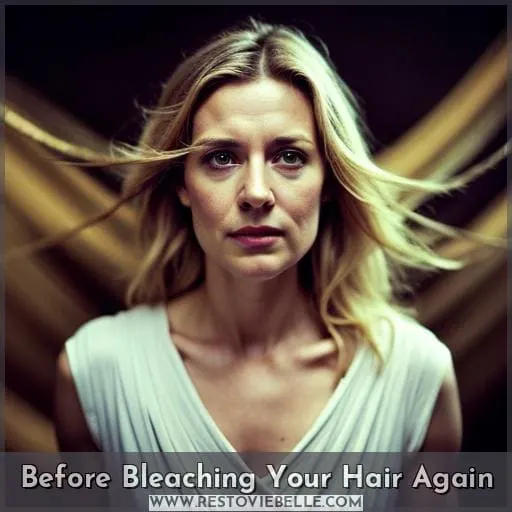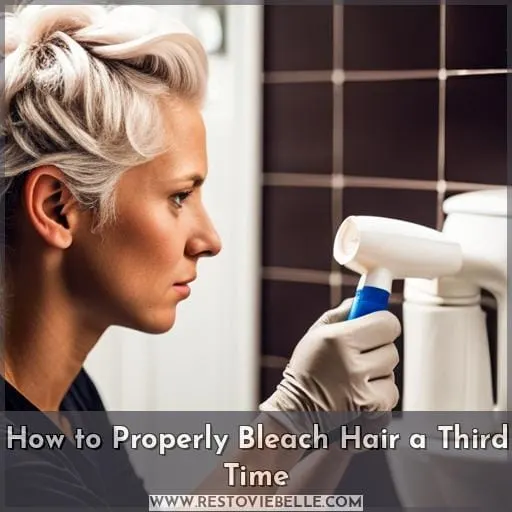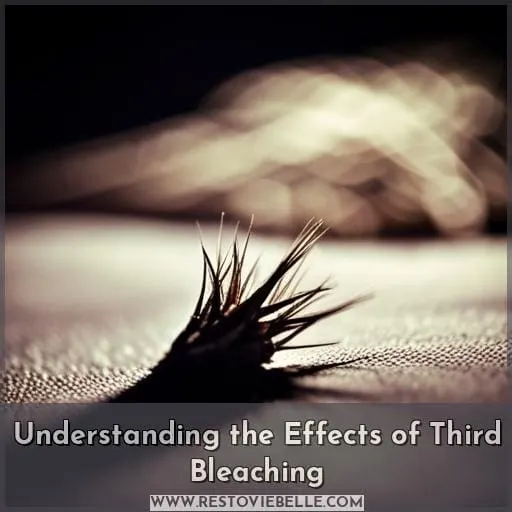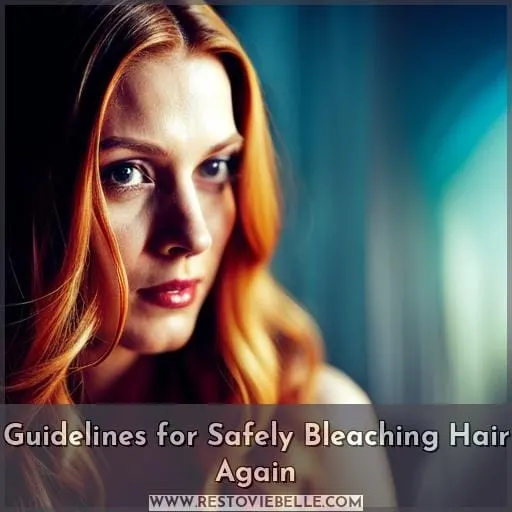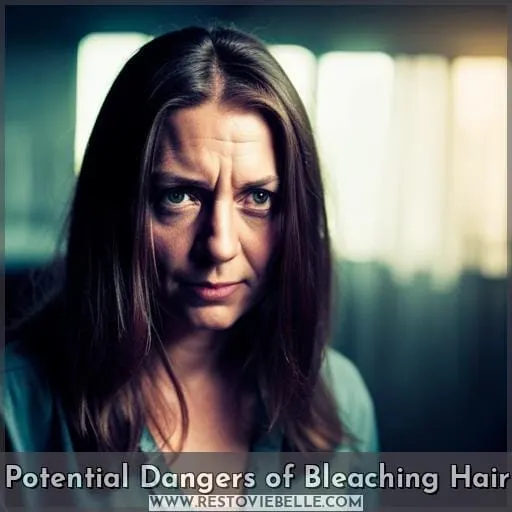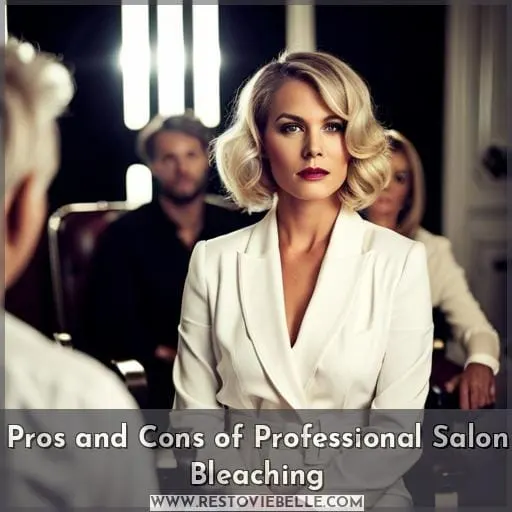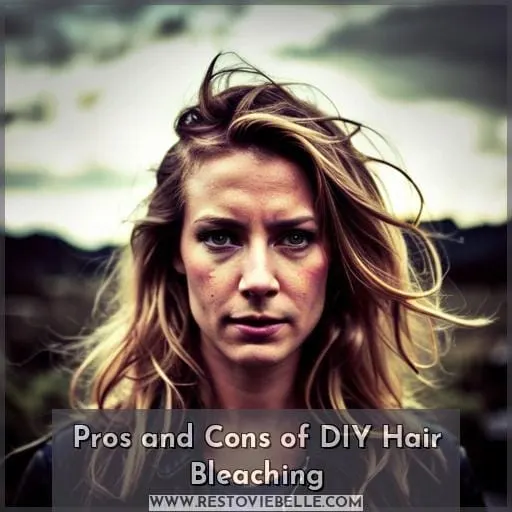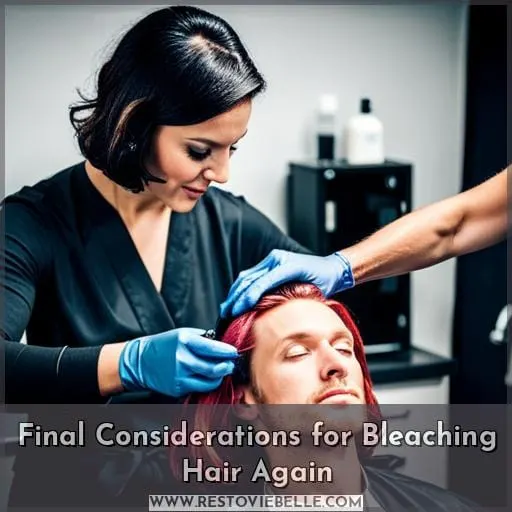This site is supported by our readers. We may earn a commission, at no cost to you, if you purchase through links.
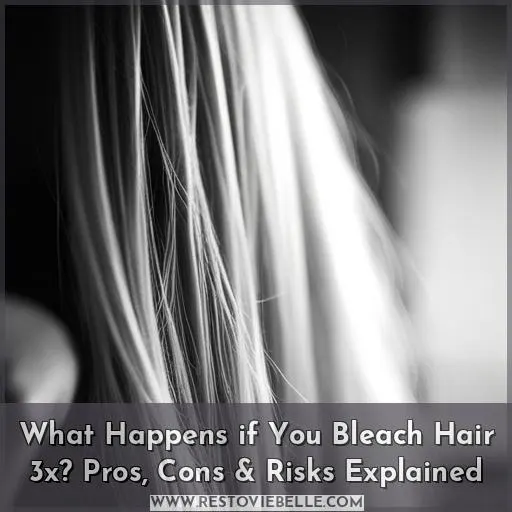 Are you considering bleaching your hair for a third time? It’s important to understand the potential risks and effects before taking the plunge. While it’s possible to lighten your locks more than once, this process can be damaging if not done correctly.
Are you considering bleaching your hair for a third time? It’s important to understand the potential risks and effects before taking the plunge. While it’s possible to lighten your locks more than once, this process can be damaging if not done correctly.
However, that doesn’t mean there aren’t ways to safely achieve beautiful results. This article will provide an in-depth look at what happens when you bleach your hair three times, along with tips on how to do so without causing irreparable damage.
Table Of Contents
- Key Takeaways
- Before Bleaching Your Hair Again
- How to Properly Bleach Hair a Third Time
- Understanding the Effects of Third Bleaching
- How Often Can You Bleach Your Hair?
- Guidelines for Safely Bleaching Hair Again
- Potential Dangers of Bleaching Hair
- Pros and Cons of Professional Salon Bleaching
- Pros and Cons of DIY Hair Bleaching
- Final Considerations for Bleaching Hair Again
- Frequently Asked Questions (FAQs)
- Conclusion
Key Takeaways
- Bleaching hair a third time can lead to damage and should be carefully considered.
- Assessing hair health and resistance is important before bleaching hair again.
- Performing a strand test can help gauge hair’s resistance and determine the appropriate lightening levels.
- Patch testing for allergies and considering hair type is essential before applying bleach.
Before Bleaching Your Hair Again
Before bleaching your hair again, it is important to take into consideration several factors. Performing a strand test helps gauge your hair’s resistance and lightening levels, while assessing its health allows you to determine if it can withstand the process.
It is also essential to consider how much time has passed since your last bleach session in order to achieve successful results without further damaging the hair.
Importance of Doing a Strand Test
You won’t believe the damage you could do if you don’t perform a strand test before bleaching your hair again! Tips to know include the strand test process, using coconut oil, and determining the developer volume.
It is also important to consider hair recovery between sessions, the risks of bleach, cold water rinsing, and the harmful chemicals in bleach. Additionally, factors such as hair strand strength, the time gap for bleaching, and the treatments needed after a bleaching session should be taken into account.
Assessing Hair Health and Resistance
Assessing your hair’s health and resistance before bleaching is essential to avoid damage. Resistance varies based on condition, so a strand test can gauge lightening and bleach resistance. Coconut oil protects scalp oils while using a 30 vol developer for a maximum of 20 minutes should be used for the process itself.
Afterwards, repair with serums or masks, but wait 6-8 weeks between sessions to prevent protein breakdown from color removal due to high pH levels in home bleach products.
Timing Considerations
It’s important to consider the timing of your last bleaching session before deciding if a third one is right for you – don’t rush it!
To ensure bleach safety, wait 8-10 weeks after each prior process, and make sure hair does not show significant loss or become chewy.
When applying bleach with oil sections in mind, expose the strands no more than 30 minutes maximum. Otherwise, color removal can be severe and lead to hair damage requiring extensive repair treatments like Olaplex.
Patch tests are also recommended for checking allergies; damaged hair is unsuitable for this step as well as DIY home bleaching, which can have harsh pH effects on already weakened locks due to back-to-back processes.
Understanding these precautions will help protect your tresses from further damage while keeping their vibrant hue intact!
How to Properly Bleach Hair a Third Time
When bleaching your hair for the third time, it is important to ensure that you are using the correct developer volume for your hair type. It is also essential to section your hair and apply the bleach evenly to achieve an even result.
After bleaching, rinse your hair thoroughly with cold water before shampooing and conditioning. Finally, follow up with post-bleach care such as serums or masks to protect the health of your hair.
Using the Right Developer Volume
Choosing the correct developer volume is essential to ensure successful results when bleaching your hair a third time. Volume 20 developer provides maximum lightening with minimal damage, protecting from the harsh effects of multiple bleaching, such as weakened hair and pigment loss.
A strand test should be done beforehand to assess resistance. Additionally, a patch test can identify allergies before proceeding. Hair protection and post-bleach care are important for restoring health in between sessions.
Using conditioners, masks, and other products will help prevent further damage during this process.
Remember that bleach opens the cuticle, dissolving color. It is crucial to avoid leaving it on for too long, as this can risk severe harm.
Sectioning and Applying Bleach
Sectioning your hair and applying the bleach can be like painting a wall, so make sure you cover every inch with care. For bleaching safety: use 20 vol developer, patch test for dye allergies, and consider home versus salon bleach.
Cold water rinses help to mix developer and bleach before proper application. Bleaching precautions include protecting scalp oils with oil, conditioning between sessions, and following directions carefully.
Rinse and Post-bleach Care
After you’ve applied the bleach to your hair, it’s important to rinse with cold water and use nourishing conditioners or masks for post-bleach care. Protecting your scalp oils is key while lightening levels should be monitored during this process.
Patch test for any potential allergies caused by color stripping due to bleaching agents, as well as check hair porosity before continuing with treatment.
To repair and recover from damage, apply a toner or deep conditioning mask that will help replenish lost proteins in strands of the hair after the third bleaching session has been completed.
Understanding the Effects of Third Bleaching
Bleaching your hair a third time can cause serious damage to the protein bonds and color molecules in the hair, resulting in raised cuticles and other harsh effects. It is important to understand both the risks involved with bleaching as well as how to take precautions before attempting it again.
Hair Protein Breakdown and Color Removal
Bleaching your hair a third time may lead to serious protein breakdown and intense color loss, leaving you feeling frustrated and disheartened. Coconut oil can help protect scalp oils while bleaching powder helps strip the color.
Hair porosity also affects lightening limits as well as pH levels of bleach, which could damage it further. Repairing with masks or serums is important after bleaching, but understanding your hair’s resistance to lightening beforehand ensures safer results.
Harshness of Bleach and Cuticle Raising
You can expect harshness and cuticle raising when bleaching your hair a third time, so it’s important to take extra precautions. Ammonia and peroxide in bleach open the cuticle, dissolve color, and break down protein bonds.
Different developer volumes have different lightening effects; 20 vol is considered safe for most hair types while 40 may be too strong! DIY at home carries risks like pigment loss and weakened keratin bonds – follow directions carefully and wear protective gear for best results.
Risks and Precautions
Before bleaching for a third time, it’s important to understand the risks and take precautions. Patch test for allergies, consider hair types and developer volume; avoiding damage through proper steps is key! Scalp burns can occur with bleach duration exceeding 30 minutes, while porosity varies depending on hair repair needs.
Hair damage prevention should include coconut oil application along with careful assessment of post-bleach treatments.
How Often Can You Bleach Your Hair?
Deciding how often to bleach your hair should be approached with caution. Ideally, the time gap between bleaching sessions should be 8-10 weeks, and there are limits to the frequency at which you can safely bleach your hair, allowing for proper recovery of damaged strands in between sessions.
Ideal Time Gap Between Bleaching Sessions
It’s essential to know the ideal time gap between bleaching sessions to protect your hair from damage and keep it beautiful. The range of safe bleaching can vary based on the chemical process, color effects, type of bleach used, and hair safety.
To prevent damage from a third-time bleaching session, wait at least 6 weeks before reapplication for long-term care.
Limits to Bleaching Frequency
Carefully consider your hair’s condition before deciding whether you can safely bleach it a third time. Different types of hair react differently to bleaching due to porosity, and strand tests can gauge resistance and lightening.
Pigment loss, weakened strands, or coconut oil not protecting the scalp are signs that further processing could be damaging. Developer volumes also play an important role; 20 vol is considered safe, but higher levels should be avoided for longer than 30 mins maximum – patch test first! The pros & cons of home vs salon bleaching should also be weighed up: DIY is tempting yet risky unless handled properly through following directions & wearing protective gear while checking lightness every 5-10 mins.
Hair Recovery Between Sessions
Take a break between bleaching sessions to allow your hair time to recover. Hair protection is key – coconut oil can help shield from damage and maintain blonde hair color. Keep bleach types, strength, and strand testing in mind for safety when lightening or dyeing locks.
To make sure the process goes smoothly, use these tips:
- Perform pre-bleach checkups.
- Follow directions and wear protective gear.
- Apply coconut oil before bleaching.
- Use maximum 20vol developer as instructed.
- Monitor results every 5-10 minutes during the session.
With this approach, you’ll enjoy healthy, glowing tresses after each bleach job!
Guidelines for Safely Bleaching Hair Again
It is important to perform a strand test and assess the hair before deciding whether or not to bleach it again. Proper application techniques, post-bleach care, and maintenance are essential for avoiding damage when bleaching your hair a third time.
Taking these precautions will help create the desired look while also protecting your locks from potentially severe harm.
Importance of Strand Test and Hair Assessment
Before bleaching your hair a third time, assess the condition of your locks and take a strand test. Hair types have different porosities, plus variable resistance to bleach strength. Developer levels 5-40 vary in duration; use 20 vol for a maximum of 20 minutes. Protect scalp oils with coconut oil as color is stripped away from roots to ends, and the cuticle is raised by the ammonia/peroxide mix.
A patch test should be done for allergies before lightening, but damaged hair is unsuitable regardless, so repair it first.
Proper Bleach Application Techniques
Apply bleach from roots to ends, and repeat for full saturation. Use a developer volume no higher than 30 vol and a maximum bleaching duration of 20 minutes to avoid damaging your hair. Prioritize protection with coconut oil treatments before each application, patch test for allergies, and check the lightness level every 5-10 minutes.
Repair damaged hair with serums or masks pre-bleach, wait 8-10 weeks between sessions if possible, but never bleach back-to-back! Hair texture considerations vary based on condition—avoid the process entirely if it feels chewy or shows significant loss due to its resistance limits being reached.
Post-bleach Care and Maintenance
After bleaching your hair for the third time, it’s essential to give your locks some extra love with conditioners, masks, and other treatments. To ensure safety risks are minimized: 1) Monitor lightening levels; 2) keep ammonia levels low; 3) match post-bleach products to hair type; 4) use deep conditioning treatments regularly; 5) avoid over-styling or re-bleaching too soon.
Post-bleach care is crucial – nutrient-rich masks can help repair damage, while coconut oil protects scalp oils from harsh chemicals.
Potential Dangers of Bleaching Hair
Before attempting to bleach your hair a third time, it is important to take several precautions into account. It is essential to perform an allergy patch test and follow the instructions carefully, paying special attention to any warnings regarding potential risks for your specific hair type.
Additionally, protective measures must be taken in order to ensure optimal safety during the bleaching process.
Allergies and Patch Testing
It’s especially important to do a patch test before bleaching your hair again, as allergies can cause serious and long-lasting damage.
Different developer volumes (5, 10, 20, or 30) combined with different hair types will have varying effects on the duration of the bleach process. To protect scalp oils, apply coconut oil beforehand. Choose a safe maximum time limit for bleaching, which should be no more than 30 minutes.
Make sure you are aware of how each hair type reacts differently due to its porosity when considering resistance levels.
Patch testing can help protect from pigment loss or weakened strands due to overbleaching.
Following Directions and Precautions
Take caution when bleaching your hair a third time to avoid severe damage; read the instructions carefully and follow them precisely. Make sure you use a developer strength no higher than 20 vol, do a patch test for allergies beforehand, and apply coconut oil around the scalp to protect natural oils.
Hair Type Considerations
Consider your hair type when deciding whether or not to bleach a third time – it could make all the difference! Different types of hair have varying levels of porosity, which can affect how quickly and safely color is removed.
A patch test will help you determine if you’re allergic to any ingredients in the bleach. Apply coconut oil beforehand for protection and use a safe volume developer, such as 20 vol max, over 30 minutes for best results.
If strand tests don’t show desired lightening or reveal breakage, coarseness, or gummy texture, you may need repair treatments like Olaplex before bleaching again.
Pros and Cons of Professional Salon Bleaching
When it comes to bleaching your hair for the third time, visiting a professional salon offers many advantages. With the expertise of an experienced stylist and access to specialized treatments and care, you can ensure that the lightening process is done properly without risking significant damage or loss of color.
Additionally, salons are more cost-efficient than DIY bleach kits when considering convenience factors such as timing and safety protocols.
Expertise and Coverage Advantages
When it comes to bleaching hair a third time, professional salons offer expertise and comprehensive coverage that is not easily gained at home. From patch tests for allergies to applications of bleach tailored by hair type, professionals have the know-how: 1) Professional expertise; 2) Hair coverage; 3) Patch test; 4) Bleach application; 5) Hair types.
Their experience helps ensure the best results with minimal damage from harsh treatments like ammonia or peroxide in bleach.
Specialized Treatments and Care
Professional salons offer specialized treatments and care to nourish hair after bleaching, helping you achieve your desired look while minimizing damage. Hair recovery is sped up with coconut oil applied before the process, reducing ammonia levels and protecting from allergens via patch testing.
Treatments like Olaplex also help repair breakage due to previous bleachings, as well as mask deep conditioning for stronger locks.
Cost and Convenience Factors
Deciding between DIY bleaching and a professional salon experience is like choosing between taking a risk and playing it safe – both come with their own benefits and drawbacks. Salon bleach offers pre-bleach treatments tailored to hair type and porosity to ensure optimal results.
The volume of developer also varies from 5-40 vol., but the safest option is 20 vol for a maximum of 30 minutes. Longer durations can weaken bonds in keratin proteins, leading to severe damage.
Pros and Cons of DIY Hair Bleaching
Bleaching your hair at home can be a cost-effective option, but you should take extra precautions to ensure it’s done safely. pH levels are key when bleaching, and if not monitored properly, it can cause serious damage to the scalp and follicles.
Knowing how long to keep the bleach on is essential, as leaving it in too long will destroy keratin bonds and strip away pigment from the hair shaft.
Cost Savings but Higher Risk
DIY bleaching might save you money, but it comes with a higher risk of damaging your hair. Taking the DIY approach is not for everyone. From haircare techniques and bleach volumes to ammonia levels and patch testing, be sure you know what you’re doing.
Check out different bleaching products available. Assess which ones contain high concentrations of peroxide. Choose one that offers low-level protection for your scalp oils. Remember, spending too much time in the bleach can lead to undesirable results.
Weakened hair follicles or extreme porosity are common outcomes if done incorrectly.
Importance of Following Proper Steps
It’s essential to proceed with caution when bleaching your tresses for a third time, or else you may end up like the hare and tortoise in a race – with no hair.
Before proceeding, it is important to consider one’s hair type. Take precautions such as patch testing for potential allergies and properly assess bleach duration based on pH levels. Different types of hair react differently, so be sure not to over-bleach. Follow directions carefully while wearing protective gear and check the lightness level every 5-10 minutes.
Although DIY methods can save cost, they potentially pose a higher risk compared to salon professionals who have expertise in this area.
PH Levels and Potential Damage
The wrong pH level in a bleach mixture can cause severe damage to your hair, so be sure to double-check the product you’re using. The ammonia and peroxide levels must also be carefully monitored as they affect bleaching limits.
Coconut oil treatments are recommended for extra protection against scalp oils during this process. It’s best to avoid products that contain only peroxide, as these may not give desired results or, worse still, lead to further damage of already weakened hair strands.
Patch testing is necessary before full application since many people experience allergies when exposed to harsh chemicals like those found in most bleaches used today – better safe than sorry! So, check all ingredients and always proceed with caution when it comes time for DIY bleaching projects – your locks will thank you!
Final Considerations for Bleaching Hair Again
Deciding to bleach your hair again requires careful consideration of the time between bleaching sessions, balancing desired results with hair health, and making an informed decision. It’s important to wait at least three weeks after the previous bleaching session and assess the resistance of each strand before deciding on a third one.
Taking these factors into account is essential for protecting the health of your locks while achieving desired coloring results.
Waiting Time Between Bleach Sessions
You must consider the waiting time between bleach sessions to avoid damaging your hair. Hair type and condition will affect bleaching duration, so use scalp protection along with oil treatments for best results.
A minimum wait of 6-8 weeks is ideal. However, if you have intensively treated or damaged hair, it’s advised that you wait up to six months before considering another bleaching session. Bleaching strips color, which can lead to pigment loss and weakened keratin bonds.
Balancing Desired Results and Hair Health
For best results and to protect your tresses, it’s important to balance desired lightening with hair health. Bleaching comes with limits: breakage, weakened strands, pigment loss can occur if not done safely.
Hair recovery between sessions is key; nourish locks using conditioners & masks post-bleach. Color removal should be monitored closely – too much peroxide or ammonia causes damage while 30 vol developer maxes out at 20 minutes for safe bleach application.
Consider strand tests before bleaching again; coconut oil helps prevent scalp dryness during the process and Olaplex treatments repair any existing damage prior to the third time bleaching session.
Making an Informed Decision
Before bleaching again, consider all the factors to make an informed decision. Hair health and repair attempts should be assessed before attempting a third bleach. Porosity and resistance vary between hair types, so strand tests are important for gauging lightening levels.
Coconut oil can help protect the scalp oils from any harshness of bleaching products. DIY methods require caution due to high pH levels that may cause pigment loss or weaken keratin bonds in longer exposure times than 30 minutes max – patch test first! If going to a salon, their expertise will cover safety measures like protective gear and treatments for recovery post-bleach session.
Frequently Asked Questions (FAQs)
What type of hair is best suited for bleaching?
Hair that is healthy and strong, with a low porosity level, is best suited to withstand bleaching.
How can I prevent hair damage when bleaching?
To prevent hair damage when bleaching, make sure to perform a strand test before starting and use only 20 volume developer. Wait three weeks after previous sessions and nourish with treatments like Olaplex.
Apply coconut oil for protection, then section your hair to mix bleach with oil evenly. Monitor the lightness level every 5-10 minutes – if it feels chewy or shows significant loss, stop immediately! DIY is tempting but risky; seek expert help for the best results.
Are there any alternatives to bleaching hair?
Yes, there are alternatives to bleaching hair. Try semi-permanent dyes for a less intense look; they deposit color without damaging the hair. For dramatic changes, consider highlights and lowlights instead of bleach; you can achieve bold looks with minimal damage.
Is it safe to bleach colored hair?
Bleaching colored hair can be a tricky process, like walking on eggshells. It is possible to achieve lightening results safely with the right product and knowledge; however, it’s recommended that you consult a professional for the best results as bleaching too often can cause damage.
Are there any long-term effects of bleaching hair?
Long-term effects of bleaching hair can include weakened strands, pigment loss, and increased porosity. High pH products can cause breakage and damage to the cuticle layer. To reduce risks, consider professional salon treatments for better coverage and expertise, or use proper DIY steps with caution if attempting at home.
Conclusion
You’ve heard it before – don’t overdo it! When it comes to bleaching your hair, the same applies. Bleaching your hair a third time can be a tempting DIY solution, but if you don’t take the proper precautions, you could be left with severely damaged hair.
Taking the time to perform a strand test, assess your hair health, and understand the risks of back-to-back bleaching is crucial to maintaining healthy and strong hair. Professional salon bleaching is the safest option, as hair experts are able to use the correct developer volume and provide specialized treatments to minimize damage.
Ultimately, understanding the potential dangers of bleaching hair and balancing desired results with hair health is the key to making an informed decision for a third time bleaching session.
